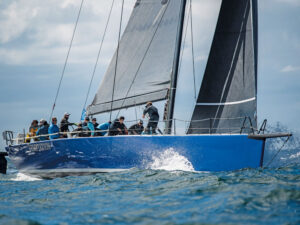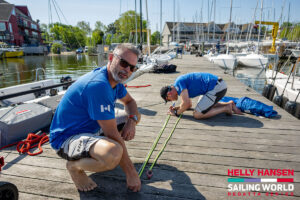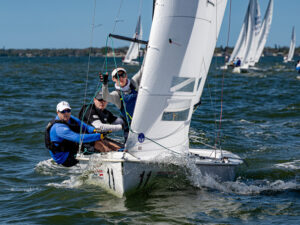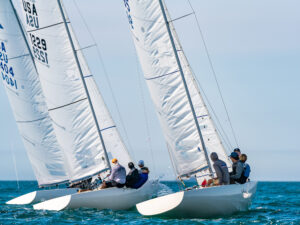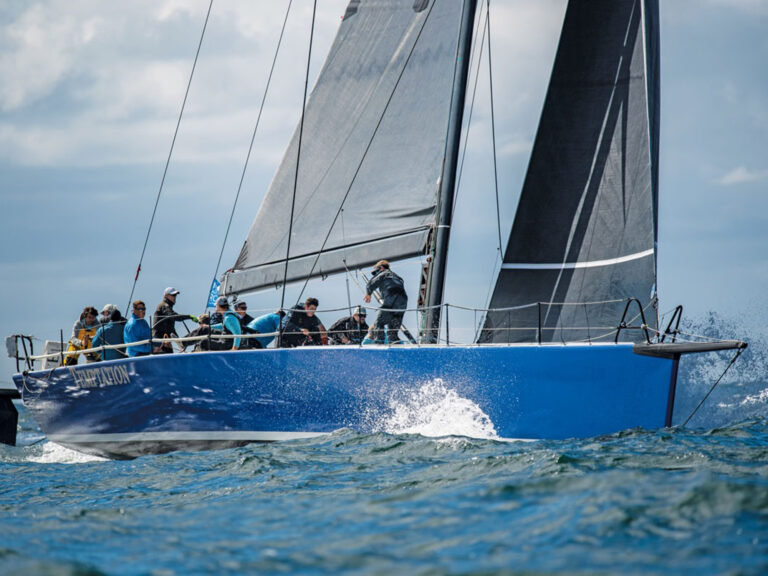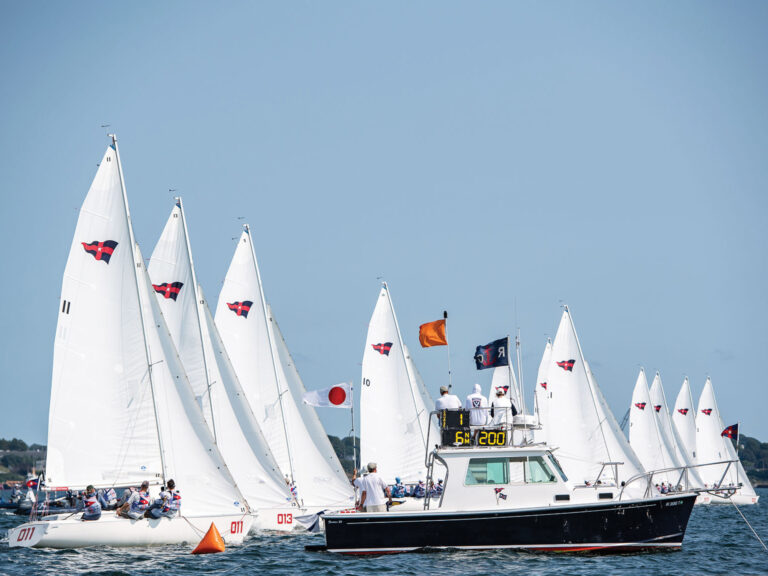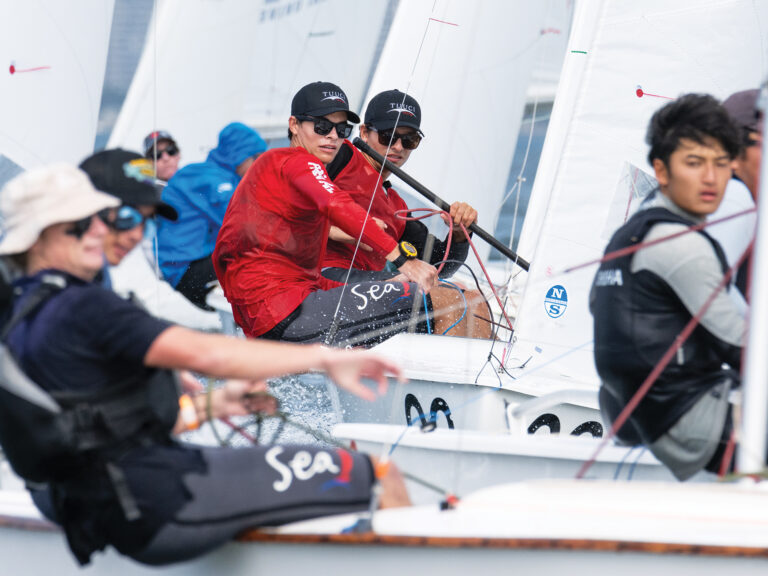
Shift Into Your Point Gear
The ability to point is an important part of any boatspeed toolkit. In many cases, having the ability to point is just as important as having great speed through the water. There are many instances when being able to outpoint the boats around you is incredibly helpful, especially in executing your tactical game plan: We all appreciate how critical it is to be able to clear out the boat to windward at the start in order to have the opportunity to tack, or to hold a lane as long as possible when a boat has tacked close to leeward.
Most sailors recognize that sailing in point mode, or point “gear,” puts the boat in a fragile, somewhat demanding trim and tune. If the boat is sailed too high or too long in point gear, it can easily stall, and you’ll slip sideways. When conditions make it challenging to steer and maintain speed (for example, when it’s choppy, wavy, or very light or very windy), your ability to maintain a point mode is significantly shorter than it would be when sailing in flat water or medium winds. Sometimes, you may only maintain point mode for a matter of seconds, sometimes it may be as long as a minute.
The characteristics of the boat, and how it handles this critical trim, must be taken into account. Some boats, like a few of my favorites, the J/22 or Thistle, can carry longer and further in point mode when compared to boats like the Flying Scot or Lightning. It’s important to recognize, however, that superior height is generally obtained at the expense of speed. The key is compromising as little speed as possible.
The old adage, “foot then point,” says a lot. The boat must be moving well so there’s flow over the blades, preventing the boat from stalling. The bottom line is, make sure the boat is sailing at top speed for the conditions before trying to pinch.
When sailing in point gear, the boat should be sailed near flat. While it may seem contrary to what many profess—that sailing heeled will encourage the boat to point—a flatter, balanced boat is key. When the boat is flat, the blades will be vertical for maximum efficiency, and the boat will be balanced. (Of course, there are some exceptions like Scows or some bigger boats.) But for all boats, top speed through the water comes when there’s a neutral or very slight windward helm. When the boat is trimmed and steered into point gear, we will see an increase in windward helm, but it’s important that the boat be re-trimmed to a neutral helm—quickly and easily—in order to accelerate and maintain speed.
Because you need to smoothly and consistently change gears in and out of point mode, changes to the actual rig tuning will be rare. Instead, focus on sail trim adjustments and steering to encourage the boat to gain extra height. However, it is important to be sure the rig is tuned well for the conditions. A rig that is too loose, for example, will allow too much headstay sag, and the jib will be too full. If the rig is too tight, the jib will be too flat and the boat will struggle to accelerate.
Though the leading edge of the sail plan is the jib, your jib trim will remain nearly constant throughout the range of gears, from acceleration to point. Fight the urge to over trim the jib to help pointing. With many boats, an over-trimmed jib can literally pull the bow away from the wind. In addition, an over-trimmed jib will narrow, or close, the slot between the entry of the main and the exit of the jib, and as a result, the main will stall as well. A great guide is a telltale placed on the jib leech about one-third of the way down from the head. Trim only tight enough that this telltale continues to flow. In fact, try trimming the jib sheet until the leech telltale just starts to stall, and then ease the sheet until it just begins to flow.
Jib halyard tension is important, too. Too little luff tension will allow the draf to move af in the jib further than designed and could over-flatten the entry. When this happens, the aft sections of the jib will become more rounded and will further close the critical slot between the main and jib.
It is the mainsail, and specifically the upper mainsail leech, where the majority of your pointing abilities are found in the sail plan. Closing the upper leech (“hooking” the upper batten) will create helm and encourage the boat to turn closer to the wind. Simply trimming the mainsheet (or vang in some boats) harder is the first step. Because you need to change gears quickly, the fewer the major changes the better.
In some boats, easing the outhaul can increase the mainsail’s lower depth and round the leech sections down low, which can aid the boat’s ability to point. But be careful: too much additional fullness will shut down the slot and stall the main. Easing the cunningham can flatten the entry and round and power the leech, which can help increase the helm and height, but when shifing back to lower gears in order to accelerate, be sure to reset the cunningham so the draft is properly positioned—usually 40 to 50 percent aft.
The traveler should be pulled to windward so the boom is set close to centerline, as long as the boat can remain flat and balanced when the sheet is eased back to your “foot gear.” However, when the boat is overpowered, it’s important to ease the traveler to leeward until the helm is neutral when the main is trimmed for speed and acceleration. Remember, it’s primarily the upper leech shape that provides the helm and “power” for the boat to point.
Teamwork in shifing gears from foot to point is critical, too. Maintaining the proper trim, heel, and balance should involve everyone on the team. How the boat is slowing as it points, in relationship to other boats, is valuable information that should be communicated by the crew to the helmsman. And be conscious of the gear the boat directly above you has chosen: are they eased for acceleration and will eventually roll over you?” Or is your bow out enough that you’ll be able to approach a lee-bow position and will slow them down? The helmsperson needs to focus only on steering, since pointing is a delicate trim and the boat will easily stall. Therefore, communication is key in the point mode.

